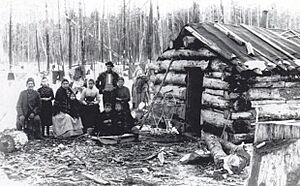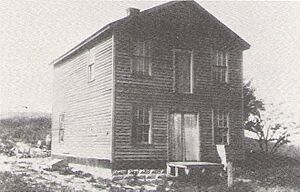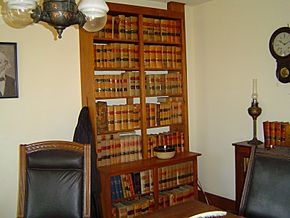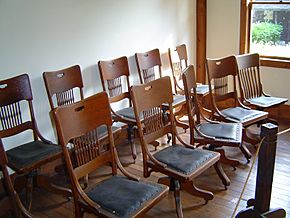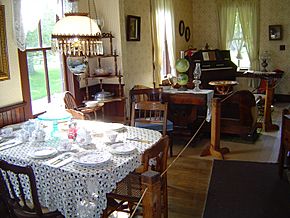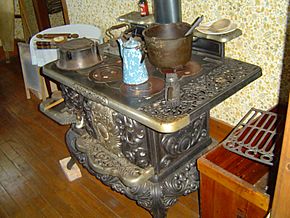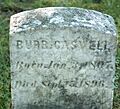Burr Caswell facts for kids
Quick facts for kids
Burr Caswell
|
|
|---|---|
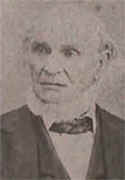 |
|
| Born | 3 January 1807 |
| Died | 15 September 1896 |
| Resting place | Lakeview Cemetery, Ludington, Michigan |
| Nationality | American |
| Other names | Aaron Burr Caswell |
| Occupation | lumberman, lighthouse keeper, civil servant, probate judge, surveyor, fish inspector, coroner for Mason County |
| Known for | developing Mason County |
| Spouse(s) | First wife Hannah Green, second wife Sarah |
| Children | 4 |
Aaron Burr Caswell (1807–1896) was an important American pioneer. He was the first white person to settle in what is now Mason County, Michigan. He held many important jobs, like being the county's first coroner, probate judge, and surveyor.
Caswell also built the first wooden house in Mason County. This house was used as his family home, a courthouse, and even a jail! It is still standing today and is a key historical landmark from Mason County's early days. Caswell also started a well-known family in Mason County.
Contents
Early Life of Burr Caswell
Burr Caswell was born in 1807 in Glens Falls, New York. He was named after Aaron Burr, an important figure in early American history. Most people called him Burr. His parents were George and Sarah (Green) Caswell.
His first job was working with wood, which he did for several years in Glens Falls. In 1837, Caswell married Hannah Green in Glens Falls. They stayed there until 1839. In 1840, they moved to Mississippi and worked on riverboats. By 1841, he moved his family to Barrington, Illinois, where they bought a farm and lived for six years.
Moving to Michigan
In 1845, Caswell took a trip to Pere Marquette Charter Township, Michigan, in Mason County. He spent the next two years hunting and fishing in the area. The closest white settlers lived about 30 miles (48 km) north in the town of Manistee.
In 1847, Caswell briefly returned to Illinois. He went to bring his family back to Michigan to live there permanently. Burr was 40 years old at the time, and his wife, Hannah, was a year or two younger. Their children were Mary (15), George (13), Helen (10), and Edgar (7).
Caswell sold their farm in Illinois but kept their oxen, cows, and pigs. With the money from the farm sale, he bought enough supplies for a year. Their journey to northern Michigan was about 300 miles (480 km). The Caswell family and their farm animals sailed on a ship called The Eagle from Chicago. They sailed north on Lake Michigan to Pere Marquette Township.
When they reached the Pere Marquette River, the water was too shallow for their large ship to dock. So, they used a small sailboat called a yawl to get to shore. Their farm animals had to go overboard and swim to land! A relative, Frances Caswell Hanna, wrote about their exciting arrival in her book Sand, Sawdust and Sawlogs.
Building a New Life
The Caswell family was the first permanent white family to settle in the Pere Marquette Lake area. This was a wild, undeveloped frontier. Burr Caswell had a good relationship with the local Ottawa Native Americans. He learned about their customs and beliefs.
His family lived in a thick forest. In 1849, they built a small two-story wooden house using old driftwood. It was close to a Native American village called Nin-de-be-ka-tun-ning. This village had rectangular lodges made of bark and logs with dome-shaped roofs.
Caswell's house was the first wooden building in Mason County. It still stands today at White Pine Village. This is an outdoor museum run by the Mason County Historical Society. The house is a main attraction there, very close to where it was first built.
Caswell kept improving his farm while also working in the lumber business. In 1855, Mason County officially became a county. Caswell allowed the first floor of his farmhouse to be used as a courthouse and a trading post. His family then moved upstairs to live.
The Mason County Courthouse was located at Caswell's house from 1856 to 1861. Judges and lawyers would travel there on horseback. For many years, Caswell produced lumber and wooden shingles from the local trees. These products were shipped to Chicago for building. He used a boat called Ranger for years to deliver his lumber.
The village that grew around the Caswells was named Pere Marquette. It was later renamed Ludington. This name honored the missionary Jacques Marquette, who died in the area in 1675. The land around the village was known as Pere Marquette Township.
Caswell was a delegate for the Republican Party in 1868. He was elected county treasurer and served on the county board. Caswell was also the first surveyor, coroner, probate judge, and fish inspector for Mason County.
Later Years
Caswell and his oldest son first worked as fishermen and trappers. Later, they worked at the Baird and Bean Lumber Mill in downtown Ludington, Michigan. Caswell's first wife, Hannah Green, passed away in 1870. After this, he moved to downtown Ludington and became the manager of a local shingle mill. In the 1870s, he worked as a foreman at Moulton & Flagg, another shingle mill in Ludington.
In 1871, Caswell married Sarah Billings. In 1873, they moved into the Big Sable Point Lighthouse. Caswell eventually became its lightkeeper. He was the fourth keeper of the lighthouse, serving from January 9, 1874, to July 17, 1882. They lived in the lighthouse until 1878.
Caswell and his second wife later moved to Mitchell, South Dakota. There, they ran a large hotel. The family returned to Ludington in 1886. Caswell died there ten years later. He is buried in Lakeview Cemetery in Ludington, next to his first wife.
Caswell's Family
Caswell's daughter Mary was born around 1835. She married Richard Hatfield at the Caswell farmhouse in 1854. Hatfield became a well-known fruit farmer. Their marriage was the first one recorded in Mason County. Mary had fourteen children, but nine of them passed away before she did in 1882.
Helen, Mary's younger sister, was born around 1837. She married Sewell Moulton. Caswell's youngest child was Edgar, born in 1840 in Illinois. Edgar married Julia Genia in 1871 and became an important businessman in Ludington.
Caswell's Historic Home
Caswell's home was very important to Mason County's early history. Besides the second floor where the family lived, the house had many uses. The front half of his home was the first county seat and the first courthouse in Mason County. The kitchen was used as the county's first store and post office. The basement even served as a temporary jail!
The building is recognized as a Registered State Historic Site. The Mason County Historical Society fully restored the house between 1965 and 1976.
Images for kids


